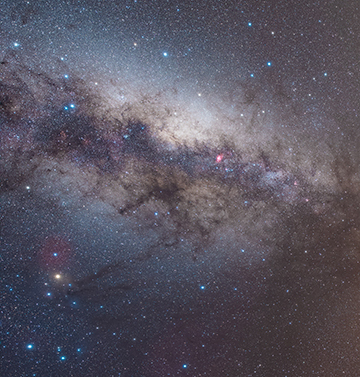Well, here we are in winter, again. It feels like it happens every year. But that’s great for stargazers if the weather behaves itself. I often get asked ‘What’s the best time of year to see the stars?’. There’s not really a clear answer to that unless you’re actually asking ‘What’s the most convenient time of year to see the stars? In that case the answer is definitely winter. Unless you’re the kind of person who only enjoys seeing the milky way after 10pm as is the case in mid December. In June, you are able to see the milky way by 6pm, and that’s great for kids who need to be in bed by 7 or 8. Or kids who get up at 5am when the stars are still visible by 7. Maybe take them out to see the stars before the sun rises.
Another glorious sight made more convenient in winter is the central core of the milky way. Yes, there’s a centre to the milky way and we don’t always get to see it. It’s one of the brighter regions of the whole ‘band’ of the Milky Way Galaxy. By July – August, it is high overhead in the earlier hours of darkness. Not only is it a beautiful, bright region of the galaxy, but in a dark enough place such as Wairarapa Dark Sky reserve, you can even see detail of the darker dusty filaments that block starlight from the billions of stars further behind. One of these darker patterns is known as the ‘Galactic Kiwi’ or Milky Way Kiwi. A long exposure photo makes the kiwi shape quite obvious.
There are some constellations and regions of the milky way that disappear from the night sky at certain times of year, and some that don’t. They just seem to be in different places. One feature that disappears for a time is the star cluster known as Matariki (The Pleiades). Since it moves through the northern half of the sky for us, it rises and sets and by late April, is lost in the lingering glow of sunset. To many Māori, this period is the ‘reset’ at the end of the year. Matariki will not be seen again until early – mid June, in the glow of sunrise. This is when the dawn viewings happen. Not quite so convenient for the modern human to observe but a beautiful sight if you make the time to catch it. Better yet, look into whether your local Marae or community organisation is holding an event you can join. You’ll want to have a good view to the northeast horizon.
With our modern conveniences, human beings have generally lost touch with these cycles of nature, but winter is a great time to reconnect. That’s what Matariki is all about. Not just in our connection to the stars, but to each other. Celebrating Matariki as a national holiday is one step towards honouring those cycles, our shared origins as humans, and our fundamental connection to the universe we’ve emerged in. I hope you’ll see some of the spectacular sights the winter night sky offers.
In tying in with Te Maramataka (Māori Lunar Calendar), the official date of Matariki 2023, the Māori new year, is July 14th.



